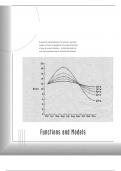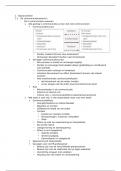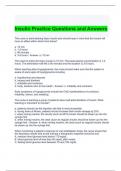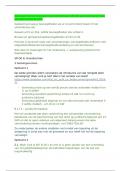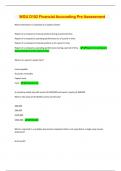Samenvatting per week
Read the articles before the lecture!!
We will look at the main steps of intervention development
Exam after lecture 3 and after lecture 5
We will use the preceed-procede model as a background and foundation
We will focus on important aspects of the models
Assignments will be introduced in the seminars
Exam is open book!!! But you do need to know what the articles are about!
For exam 2:
They will not ask something that is not touched upon in the lectures. So you should know the
relevant parts of information that are discussed in the lectures and then go and check more
information about this in the papers.
Notes week 1 – Systematic program planning
Info from course manual:
Policies and Interventions are critical tools to address social issues in the domains of work, care and
participation; youth and family; and diversity and integration. This lecture is concerned with the
importance of and approaches to systematic development of effective interventions and policy. The
focus of the lecture is on introducing and discussing the diversity of planning models that have been
proposed to guide the development of responses to social issues.
Notes during reading:
Two models:
- Precede-Proceed model
- Intervention mapping protocol
Precede-Proceed model
Crosby and Noar
What is a planning model? An introduction to PRECEDE-PROCEED
Richard Crosby, PhD1 ; Seth M. Noar, PhD2
The PPM guides the program planner to think logically about the desired end point and work
“backwards” to achieve that goal. This observation teaches a vital lesson, namely that program
planning is larger and is a more comprehensive task compared to the subservient function of theory
selection and application.
A theory is a tool that allows one to inform and strengthen practical solutions to old and emerging
problems in public health.
A planning model is much different than a theory. Planning models exist at a macroscopic level; they
serve as an organizing framework for an entire health promotion effort aimed at fostering reduction
in a given disease. Unlike theories, planning models are not made up of a set of testable
propositions. Rather, planning models serve as a blueprint for building and improving intervention
programs.
,Theory is an essential part of that blueprint, one that is necessary for building a successful program.
A particularly useful, widely applied, and easy-to-follow example of a planning model is the
PRECEDE-PROCEED planning model (PPM) (5). PRECEDE stands for Predisposing, Reinforcing, and
Enabling Constructs in Educational/ environmental Diagnosis and Evaluation. Generally speaking the
PRECEDE phases correspond with steps 1 through 4 of the model as depicted in Figure 1. PROCEED,
on the other hand, stands for Policy, Regulatory, and Organizational Constructs in Educational and
Environmental Development. This aspect of the model begins with step 5 of the model depicted in
Figure 1. The PPM is a framework that, when used properly, guides the user to engage the target
community to develop a sound ecologically based approach to the problem at hand.
The PPM is very much an ecological approach to health promotion. In a nutshell, an ecological
approach means that all aspects of a person’s environment are considered as potential intervention
targets, as well as the person’s own cognitions, skills, and behavior. Which way of intervening is
most successful for a certain case often differs per region and the resources within that region.
Sometimes only an individual intervention is best, but sometimes you should look at the larger
picture, like advertisement and politics. An ecological approach acknowledges these “higher-order”
influences on health behavior and seeks to address those factors that can be changed or mitigated at
the community level
it is now also important to understand that intervention efforts require constant maintenance and
updating. This is precisely why evaluation is so critical. Program evaluation provides“built-
in”mechanisms for feedback to the program planners to make judgments about what is working and
what requires refinement. Again, being quite distinct from theory per se, evaluation is a macro-
function of planning models
Taken down to a simple concept, the maxim implies that all programs should be developed through
extensive involvement of community members – sometimes even to the extent of engaging these
folks in the planning process, including evaluation
The PPM – zie uitgebreid figuur in artikel
Planning begins with the largest goal (improved quality of life) and culminates in an administrative
and policy assessment.
STEP 1 – Social Diagnosis
The goal of an interventions is improved quality of life as defined by the community. Answering a
host of questions are vital tasks in the process of making a thorough social diagnosis of a problem
that might exist in a community. Once the social diagnosis is well underway, it is wise to form a
community advisory board (CAB). A 10-member CAB, for example, may be a good way to begin
finding out more about the community and what, who, and how the change efforts might look like in
an ideal scenario. Community participation is a key aspect of the PPM. From this point forward, the
CAB becomes an integral part of the entire planning and evaluation process. Thus, maintenance of
the CAB is a key task.
STEP 2 – Epidemiological diagnosis
The goal of this step is to create measurable health-related objectives. In essence, these objectives
become the standards by which you will ultimately judge the success of the program. More
importantly, the objectives serve as the overarching guides for the remainder of the planning
process. The objective should be measurable and have a time limitation. Every objective will have
,sub-objectives. Sub-objectives are simply steps that must be taken (and met) to achieve objectives. It
is not unusual for one objective to require three or more subobjectives
STEP 3 – Behavioral and environmental diagnosis
Meeting the health objectives requires changes in both the behavior and environment. The
identified environmental and behavioral factors will become the sub-objectives that direct the
remainder of the planning and intervention activities. Program planners frequently make the initial
mistake of confusing environmental sub-objectives with behavioral sub-objectives. Behavioral sub-
objectives instead, may be a product of changes to the environment or it may be a direct
consequence of the health promotion program. Environmental subobjectives are often directed
toward setting the stage for achievement of the behavioral sub-objectives. Considering
measurement is indeed a pivotal aspect of the writing of sub-objectives.
STEP 4 – Educational and ecological diagnosis
The overall task here is to develop a plan designed to achieve the very first subobjective that was
developed in step 3. Then, a very different plan is developed to achieve the second sub-objective
and so on. This is the point in the process when the planner must consider the predisposing,
reinforcing, and enabling factors (the PRE of PRECEED)
Predisposing: Predisposing factors exist at the cognitive level. Thus, constructs such as self-efficacy,
attitudes, and beliefs are all predisposing factors
Reinforcing: Maintenance, reinforcement is a method of helping to assure the desired behavior
recurs.
Enabling: Enabling factors represent the necessary conditions that must be present for the behavior
to occur.
Doing a PRE-analysis
All behavioral sub-objectives developed in step 3 must be analyzed for their respective predisposing
and reinforcing factors. Furthermore, the behavioral sub-objectives should each be analyzed for any
applicable skill-related enabling factors. Note, however, that enabling factors that pertain to
changing the environment may have already been identified in step 3 as environmental sub-
objectives. In the end, the program planner will conclude this step by having a long list of step 4 sub-
objectives that must be met through planned activities. The question of how best to exhaustively
identify all relevant step 4 sub-objectives and how best to achieve each one is, of course, daunting.
Fortunately, this is where theory comes into play.
This is where theory comes into play. The PPM does not prescribe any one theory. Instead, it allows
for the fact that every program will have different objectives, and thus, theory should be used as
needed à using theory is part of step 4. Again, the PPM can be used to direct theory selection
efforts. Which theory (or theories) is/are selected is very much a product of the step 4 sub-
objectives.
Which theory (or theories) is/are selected is very much a product of the step 4 sub-objectives
Already develop the intervention. What determinants are you gonna handle how?
STEP 5 – Administrative and policy assessment
Is your plan possible and how? What needs to be considered in the specific environment.
, The initial task is to assess the capacity and resources available to implement programs and change
policies such that the step 4 sub-objectives can be met. In step 5, the goals can be divided into two
categories: health education and the larger, more encompassing, category of changing policy,
regulation, and organizational structures (the PRO of PROCEDE). Many of the sub-objectives cannot
be met through education alone, however. Step 4 sub-objectives that are classified as enabling
factors and do not have a skill base are achieved through changes to the environment.
It is helpful at this juncture to think about the environment in very broad terms. For a child or
teenager, as an example, the family environment is likely to be a critical determinant of oral health.
The community environment, in turn, may establish norms for families. The economic environment is
extremely profound in terms of oral health and this is tied to a host of insurance policies in the
workplace environment and the political environment.
STEP 6 – Implementation
Before implementation begins, a complete plan for program evaluation must be in place. The plan
should have three parts: process evaluation, impact evaluation, and outcome evaluation.
STEP 7 – Process evaluation
The key word here is fidelity (hoe goed het programma gevolgd is – hoe trouw aan het protocol). In
health promotion programs, the staff may or may not faithfully follow protocols and procedures
developed during the planning stages; thus, monitoring is required followed by corrective feedback.
This process of monitoring and correction is iterative and ongoing – ending only when the program
comes to a close.
STEP 8 – Impact evaluation
Were the behavioral and environmental sub-objectives (as developed in step 3) met?” Impact
evaluation determines whether the intervention achieved its intermediate outcomes, which typically
are more readily measurable than the long-term health outcomes. The impact evaluation may show,
for example, that behaviors did change at the population level. Equally important (if not more so),
the impact evaluation may also show that targeted environmental structures were successfully
changed.
STEP 9 – Outcome evaluation
Did you reach your objectives of phase 2. The phase 3 sub-objectives are really protective factors.
Protective factors, in turn, reduce the risk of disease by some estimated value (usually expressed as
an odds ratio in epidemiology). Risk reduction and disease prevention, however, are not
synonymous concepts
Summary
The PPM guides the program planner to think logically about the desired end point and work
“backwards” to achieve that goal. Through community participation, the planning process is broken
down into objectives, step 3 sub-objectives, and step 4 sub-objectives. Conceptually, this approach
to health promotion provides context to the use of theory, with theory being applied at the fourth
step. This observation teaches a vital lesson, namely that program planning is larger and a more
comprehensive task compared to the subservient function of theory selection and application. In
essence, saying that a program is “theory-based” is a far cry from assurance that it will be sound and
effective.
Whatnall
A Brief Web-Based Nutrition Intervention for Young Adult University Students: Development and
Evaluation Protocol Using the PRECEDE-PROCEED Model


